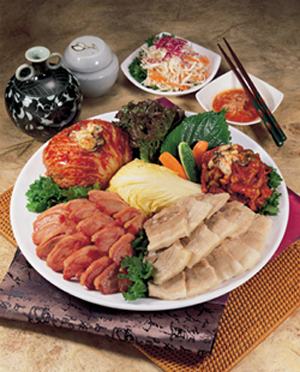More on Cabbage Kimchi – Some Guidelines
This post was originally published in February 2011 and is now updated.
I am now quite proud of my cabbage kimchi, a skill which has taken me about ten years to get right. One reason why it takes a long time to make decent kimchi is that you have to develop a sense of what constitutes a good kimchi and an awareness of kimchi at different stages of fermentation. Unless you have a cultivated appreciation of what Kimchi is, and by that I mean an awareness of kimchi that a Korean would enjoy and not what you personally think it should taste like, your kimchi will never be authentic. The subtleties of kimchi are as intricate and extensive as wine or Indian curry and an appreciation is important if you are to use a recipe to guide you.
There exist many recipes for cabbage kimchi, regional, personal and for accompanying certain meals; bo-ssam (boiled, sliced pork, 보쌈) for example, uses a special type of kimchi. I am concerned here with the standard type of kimchi that accompanies the majority of Korean foods and which can be divided into two categories, fresh and sour. There is of course, a range of flavours in between these extremes. Many Koreans have a preference for one or the other and foods which use kimchi as a major constituent, as for example with kimchi stew (김치 찌개 or 김치찜), suit one or the other.
I’m told by Korean friends that big cabbages are not the best to use and that medium sized ones, which compared to Britain are enormous, are the most suitable. The outer leaves are trimmed and unless damaged these shouldn’t be thrown away as they can be used in other recipes.
One of the most persistent problems I faced was the most crucial; namely getting the salting process right. Even cook books sometimes overlook what is a seemingly simple procedure. When the prepared cabbages are ready to paste with your kimchi paste mix, they should resemble a dishcloth by which I mean they should be floppy and it should be possible to wring them without them tearing. If you get your kimchi paste wrong you can always adjust it. Even if you subsequently discover your kimchi is too salty it will mellow as it ferments but should the kimchi fail to wilt properly it will not be easily rescued.
Many recipes gloss over the salting process and only this week I read Jennifer Barclay’s book, Meeting Mr Kim (Summersdale, 1988). The book is an interesting account of life in Korea and not a cookbook, but her kimchi recipe, and she is not alone, simply directed you to soak the cabbages in salted water. If as recipe does not explain the salting process in some detail, tread with caution! I once used an entire big bag of table salt in which I soaked the cabbages for several days and they still failed to wilt effectively. The salting process is actually simple if you use a coarse type of salt (such as sea salt or if in Korea 굵은 소금)) and sprinkled between the leaves is all that is required to wilt the leaves in several hours, depending on room temperature. When I make kimchi in the UK, I am forced to use cabbages which are almost white in colour, very stemmy, and which are too small to quarter but even these wilt if treated properly. After salting the washed and wet cabbages they can be placed in a bowl or sink, sprinkled with extra salt and a few cups of extra water and left. Immersing them in water isn’t necessary. In hot weather the wilting process is much quicker. You should notice the cabbages almost half in volume and soon become limp, floppy and wringable.
Like rice, traditionally, Koreans rinse the cabbage three times. I have learnt it is much better to rinse them thoroughly, perhaps removing too much salt but this can always be remedied later. However, if you use the correct ammount of salt and don’t sprinkle excess on, three rinses are adequate. You can feel where salt residue remains as the stems are slimy and you can remove these by simply rubbing your fingers over them.
Salty kimchi will mellow with fermentation, it is probably better for it to be not salty enough than too salty, especially given the concerns over salt and blood pressure. One hint Mangchi suggests is adding some thin slices of mooli (무) if it is overly salty.
A good kimchi paste will cling to the leaves like a sauce so it is prudent to drain the segments and even wring water out and this will prevent your kimchi becoming watery as the cabbages ferment.
Plenty of recipes, online and in books, will guide you through making the paste but my all time favourite is Maangchi. Her website is enormous and her videos on Korean cooking are well presented. Here you will also find other ways to use kimchi as well as many other types of kimchi, cabbage and otherwise.
British friends who have since become lovers of kimchi often ask me how long it will keep. I tend to keep kimchi in the refrigerator in hot weather and somewhere cold, but not freezing, in winter. If you like kimchi fresh (newly made,) keeping it cool or cold will delay fermentation. If you like it sour then you can use a warm place to speed up the process. I tend to juggle things in order to better control fermentation. I made my last batch of kimchi in November and the tub in which it is stored has stood on my balcony almost 6 months. I have now moved it to the bottom of my fridge to mellow indefinitely. I have used kimchi that was over 6 months old and which had white mold on the top but this washed off and the underlying cabbage was excellent as the basis for a stew.
© 林東哲 2011 Creative Commons Licence.








Remarkable posting, I will be browsing back again frequently to discover fresh news.
Thanks!
I have almost finished the kimchi that you left. I tried boiling it with some pork as you suggested and it was quite delicious, though it never quite tastes the same as eating it from a tupperware dish sat in the car park at Essex Uni!! Roll on the summer!!
Hey! Thanks for the comment. I’m shortly posting a recipe for kimchi and for ways of using it. Check back.
N
I never thought I’d like kimchi. When I first started visiting Korea in the early 90s, I couldn’t eat more than a bite before tears were streaming down my face from the spiciness. Maybe I’ve gotten older and my tastebuds are not as sensitive, or maybe all those years of eating Chinese hotpot have inured me to kimchi’s particular type of spiciness, but on my last visit there I couldn’t eat enough of it. I would even ask for second helpings. I can’t get it where I’m living now, so when I pass through Korea this summer, I’ll be sure to get some more.
Yes, exactly the same happened with my sister. She hated it at first but is now wanting to learn the recipe. Thanks
I saw some 7 year kimchi on K-TV which the host looked like he was going to have a heart attack over the salt but the ajumma looked pretty chuffed. I like the nuttier kimchis like 촌각 김치(bachelor or ‘ponytail’ kimchi) or more savoury, fresh, juicy tasting ones. Cheolla-do is held up as having the ‘best’ regional food, but I like Kangwon-do style food. It’s very savoury by comparison.
Roll on the summer water kimchis!
I like the ponytail kimchi but have never made it and I’ve only once seen baby mooli in the UK and they looked one step away from being rancid. No doubt you can buy them in places like New Malden. Thanks.
Yeah, have seen mooli in Kingston but you couldn’t do that much with them. Too limp to even bother making gakdukki kimchi and not firm enough to boil in a soy sauce stock as large discs. Baby mooli? Never even seen them.
New Malden-yeah that’s the ‘Koreatown’ of sorts.I heard bad things about the restaurants there charging naive, vulnerable workers a deposit which you can imagine is not returned. Korean companies here have an odious thing about not paying full wages the first 3 months too.
I can’t remember how to spell it but do you have a recipe for duhnjimi? Radish, brine, sugar, shaved ice, a couple of gochu served in those steel rice bowls.
Do you teach in the Kingston area?
This comment I have only just discovered sorry. I don’t have a recipe for the mentioned food but will keep an eye open for it. I do have a steel bowl however, great things! The mooli in Tescos is shite and is a little bigger than a carrot and totally bendy. Last time I ate bibimbap in London it cost 16000 Won (eight UK pounds) and that was for the cold one. An extra spoonful of kimchi cost me two pounds.
No, I’m supply teaching based in Richmond. Kingston has a pretty good outdoor market and a little pojang macha of sorts.
I hear that a raw, peeled potatoes added to a soup will draw out surplus sodium, though I’ve never tried it. You might give that a whirl someday in your kimchi. You don’t leave the potatoes in, of course; I presume you withdraw them when you are satisfied.
I will give this a try. Do you reckon it will pickle the potatoes?
Later – I actually tried it and it did seem to reduce the saltiness however, the sliced potatoes quickly absorbed the red chili colour and became bendy making them indistinguishable from the other ingredients. That was almost three weeks ago so I’m wondering how they will taste when I discover them.